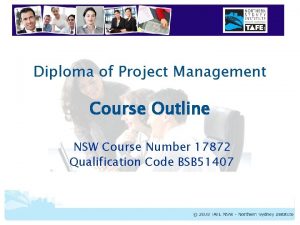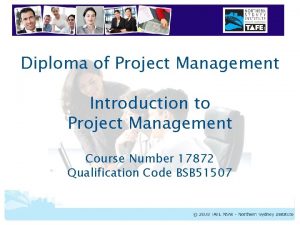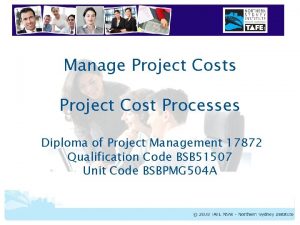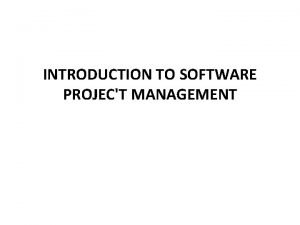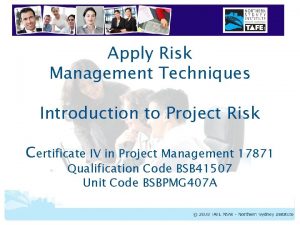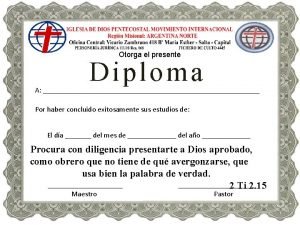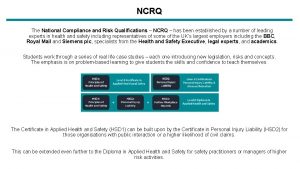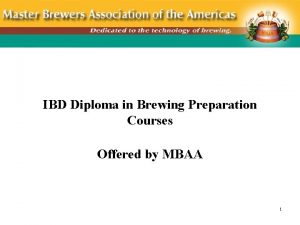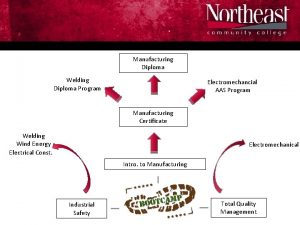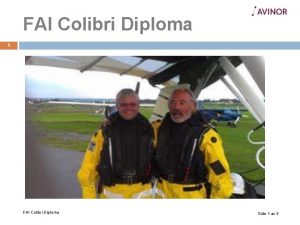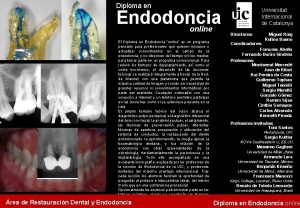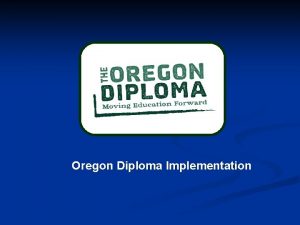Diploma of Project Management Introduction to Project Management



















- Slides: 19

Diploma of Project Management Introduction to Project Management Course Number 17872 Qualification Code BSB 51507

Recommended Reading If you haven’t done so already, please take some time to review the PMBOK Chapter 1, Chapter 2 & Appendix G This could take 45 to 60 minutes

What is a project? Definition from PMBOK • A project is a temporary endeavour undertaken to create a product, service or outcome • There is a definite beginning and end • Generally the end is reached when the project’s objectives have been met Adapted from the PMBOK 4 th edition

Examples of Projects Some Examples of Projects • Developing a new product or service • Effecting a change in an organisational structure • Acquiring and implementing a new computer system • Constructing a building • Improving a business process Adapted from the PMBOK 4 th edition

Project Characteristics Phases Materials Deliverables Temporary Planned Client Tangible Outcome Controlled Tasks Team is disbanded Monitored Cost Sponsor Scope Definite Start Long or Objectives Short Timeframe Definite End Activities

Project Success Measures • Project success occurs when the – üexpectations of the project sponsor or client are met üagreed project objectives have been met übusiness outcomes have been realised ütimeframe and budget have been delivered üquality and scope requirements have been delivered

Understanding the Requirements

Project Tradeoffs Time Re ally Cost me an s Quick Quality Cheap Good Project success is often reliant on the project manager’s ability to manage stakeholder expectations and make trade offs between key project dimensions

Project Management Roles (AIPM) • There is a natural hierarchy of roles within the project management profession • The AIPM’s competency framework has four levels Executive Project Director Project Manager Project Practitioner Source – AIPM Professional Competency Standards for Project Management, June 2008, Version 1

Project Management Roles (PMI) • The PMI has a different hierarchy of project management roles – Portfolio Manager Program Manager Project Manager • The PMI also includes a project support function known as the Project Management Office Source – PMBOK, 4 th Edition

Project Management Definition • Project Management ü The application of the 9 defined project management knowledge areas, skills, tools and techniques to deliver project requirements. ü Project management typically includes identifying requirements, addressing stakeholder expectations to ensure the project is planned and executed correctly, balancing competing project constraints such as time, cost, quality and scope, and reducing the impact of risks and issues. Source – Adapted from PMBOK, 4 th Edition

Program Management Definition • Program Management ü Grouping related projects in order to manage and co-ordinate the outcomes and enhance the achievement of benefits. ü Program management is the centralised and co-ordinated management of a set of related projects in order to achieve broad strategic objectives and benefits. ü Program management focuses on the project interdependencies and determines the optimal approach to managing the projects in order to maximise the benefits. Source – Adapted from PMBOK, 4 th Edition

Portfolio Management Definition • Portfolio Management ü Grouping of a collection of projects or programs together so they can be managed as a whole in order to achieve strategic business objectives. ü Portfolio management refers to the centralised management of a collection of related projects and programs. This includes identifying, prioritising, authorising, managing and controlling and projects and programs within the portfolio so that they align with the strategic business objectives. ü The focus is on prioritisation of resource allocation so that the portfolio objectives are aligned to organisational strategies. Source – Adapted from PMBOK, 4 th Edition

Project, Program & Portfolio Roles Project Officer Project Manager Program Manager Portfolio Manager Scope Management Roles have defined responsibilities. Work under direction of the Project Manager. Contributes to scope management. Projects have defined objectives. Scope is progressively elaborated throughout the project lifecycle. Programmes have a larger scope and provide more significant benefits. Portfolios have a business scope that changes with the strategic goals of the organisation. Change Management Contributes to change management, brings changes to scope, time, cost and quality to attention of Project Managers expect change and implement processes to keep change managed and controlled. The Program Manager must expect change from both inside and outside the program and be prepared to manage it. Portfolio Managers continually monitor changes in the broad environment. Project Planning Contributes to project planning and may take ownership of a set of deliverables or small sub project, under direction from the Project Manager. Project managers progressively elaborate highlevel information into detailed plans throughout the project lifecycle. Program managers develop the overall program plan and create high-level plans to guide detailed planning by Project Managers. Portfolio managers create and maintain necessary processes and communication relative to the planning for the overall portfolio. People Management Contributes to project human resource planning. Needs to work effectively as part of the project team. Project managers manage the project team to meet the project objectives. Program managers manage the program staff and the project managers, they provide vision and overall leadership. Portfolio managers may manage and co-ordinate portfolio management staff and ensure the overall people management framework, policies and procedures are followed. Project Success Measures Works under supervision of the Project Manager to ensure success measures are achieved. Success is measured by product and project quality, timelines, budget compliance and degree of client satisfaction. Success is measured by the degree to which the program satisfies the needs and benefits for which it was undertaken. Often linked back to a business case. Success is measured in terms of aggregate performance of portfolio components and often linked back to a strategic plan and priorities for a business unit. Monitoring & Controlling Provides status updates to Project Manager on deliverables and activities. Project managers monitor and control the work of producing the products, services and results committed to in the Project Charter. Program managers monitor the progress of sub projects to ensure the overall goals, schedules, budgets and benefits are achieved. Portfolio managers monitor the aggregate performance against strategic objectives. Source – Adapted from PMBOK, 4 th Edition

Project Management Office (PMO) • Primary function of a PMO is to support project managers by – ü Managing shared resources ü Specifying and developing the project management methodology, best practice, standards and tools ü Coaching, mentoring, training and career management ü Project assurance and compliance with methodologies and standards ü Co-ordinating communication across projects and within the project management community ü Assistance with project establishment and approval processes ü Project reviews and health checks to ensure projects are running according to plans and expected outcomes Source – Adapted from PMBOK, 4 th Edition

Project Managers vs PMOs Project Manager – Focuses on the specified project objectives – Controls the assigned project resources to best meet project objectives – Manages the constraints of the individual project (scope, time, cost, quality, risk etc) PMO – Manages major program cope changes to optimise achievement of broader business objectives – Optimises the use of shared organisational resources across all projects in their jurisdiction – Manages methodologies, standards, overall risks and interdependencies in their jurisdiction Source – Adapted from PMBOK, 4 th Edition

PM Interpersonal Skills • In addition to the ability to apply the 9 key knowledge areas, Project Managers require important interpersonal skills to assist in the effective management of projects, specifically in the achievement of project objectives and success criteria – 1. Leadership 2. Team Building 3. Motivation 4. Communication 5. Influencing 6. Decision Making 7. Political and Cultural Awareness 8. Negotiation Source – PMBOK, 4 th Edition, Appendix G Interpersonal Skills

Student Introduction Exercise 1. Please go to Tests & Tasks – Student Introduction and Assignment Selection and complete the review questions that have been assigned. 2. This is a simple survey to allow your Course Facilitator to get to know you. 3. You will also be asked to select your preference from the case studies for the Team Assignment. This will assist your allocation to a team. 4. The Case Studies can be accessed from the Learning Program – Assessment Information Team Assignment Details. 5. It is likely that you will be allocated to your preferred case study, but this cannot be guaranteed. Practice Learn Improve

Next Steps Please complete the Student Introduction & Assignment Selection exercise in Tests & Tasks before proceeding to Project Management Environment in the Learning Program. Best of Luck! This is due at the end of Week 1 in the Course Delivery Schedule and it is critical to the allocation of teams and case studies for the Team Assignment
 Diploma in project management course outline
Diploma in project management course outline Dual diploma project management
Dual diploma project management Project costing diploma
Project costing diploma American diploma project
American diploma project Introduction to software project management
Introduction to software project management Software
Software Gym management system abstract
Gym management system abstract Introduction to project risk management
Introduction to project risk management Introduction to project management kathy schwalbe
Introduction to project management kathy schwalbe Ia diploma resp
Ia diploma resp Diploma after 10th
Diploma after 10th Ib
Ib Diploma a super mama
Diploma a super mama What is the golden state seal merit diploma
What is the golden state seal merit diploma What is aice
What is aice Se otorga el presente diploma
Se otorga el presente diploma Myncrq
Myncrq Schmerling féle provizórium
Schmerling féle provizórium International skills diploma seal presentation
International skills diploma seal presentation Ibd diploma in brewing
Ibd diploma in brewing
